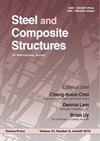利用LSFDs避免结构弱层破坏机制的动力试验与数值模拟
IF 3.9
3区 工程技术
Q1 CONSTRUCTION & BUILDING TECHNOLOGY
引用次数: 0
摘要
在强震作用下,由弱层破坏机制引起的结构破坏或倒塌对人的生命财产安全构成极大威胁。许多研究者试图通过在不安全结构上安装各种耗能装置,将这种意外破坏机制转化为期望的整体破坏机制。本文将具有硬化后屈服刚度的格状摩擦装置(LSFD)引入具有弱层破坏机制的钢框架中。然后,对三种类型的两层钢框架进行了振动台试验——一种是带LSFDs的框架,一种是带传统摩擦支撑阻尼器(fbd)的框架,一种是裸框架。重点研究了LSFD的硬化后屈服刚度对框架弱层破坏机制的地震反应。结果表明,两种阻尼结构在中、弱地震作用下的地震反应差异不大。结构最大层位移分布较为均匀,能有效抑制强震作用下的弱层破坏,而结构变形集中严重。振动台试验中对含LSFDs结构的数值模拟结果表明,简化模型结果与实验结果基本一致。因此,该模型可用于分析含lsf的阻尼结构的抗震性能。本文章由计算机程序翻译,如有差异,请以英文原文为准。
Dynamic test and numerical simulation on avoiding the weak-story failure mechanism in structures using LSFDs
The structural damage or collapse caused by weak-story failure mechanisms poses a great threat to the safety of human life and property under strong earthquakes. Many researchers have attempted to transform this unexpected failure mechanism into the desired overall failure mechanism by installing various energy dissipation devices on unsafe structures. This paper introduced a lattice-shaped friction device (LSFD), which is a friction device with hardening postyielding stiffness, into a steel frame with a weak-story failure mechanism. Then, shaking table tests of a three types of two-story steel frames—a frame with LSFDs, a frame with traditional friction brace dampers (FBDs), and a bare frame—were carried out. The seismic responses of the hardening postyielding stiffness of the LSFD on the weak-story failure mechanism of the frame were emphatically studied. The results showed that there was little difference in the seismic responses between the two damped structures under moderate and weak earthquakes. The distribution of maximum story drift for the structure with LSFDs was more uniform, which effectively suppressed the weak-story failure under strong earthquakes, whereas the structure with FBDs had serious deformation concentrations. The numerical simulation results of the structure with LSFDs in the shaking table test showed that the simplified model results were basically consistent with the experimental results. Hence, this model could be used to analyze the seismic performance of damped structures with LSFDs.
求助全文
通过发布文献求助,成功后即可免费获取论文全文。
去求助
来源期刊

Steel and Composite Structures
工程技术-材料科学:复合
CiteScore
8.50
自引率
19.60%
发文量
0
审稿时长
7.5 months
期刊介绍:
Steel & Composite Structures, An International Journal, provides and excellent publication channel which reports the up-to-date research developments in the steel structures and steel-concrete composite structures, and FRP plated structures from the international steel community. The research results reported in this journal address all the aspects of theoretical and experimental research, including Buckling/Stability, Fatigue/Fracture, Fire Performance, Connections, Frames/Bridges, Plates/Shells, Composite Structural Components, Hybrid Structures, Fabrication/Maintenance, Design Codes, Dynamics/Vibrations, Nonferrous Metal Structures, Non-metalic plates, Analytical Methods.
The Journal specially wishes to bridge the gap between the theoretical developments and practical applications for the benefits of both academic researchers and practicing engineers. In this light, contributions from the practicing engineers are especially welcome.
 求助内容:
求助内容: 应助结果提醒方式:
应助结果提醒方式:


